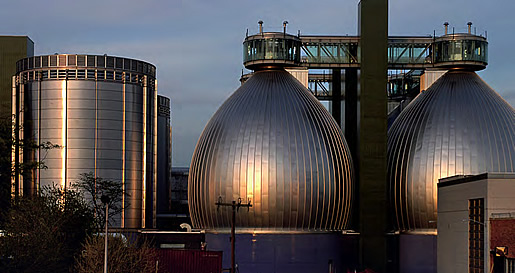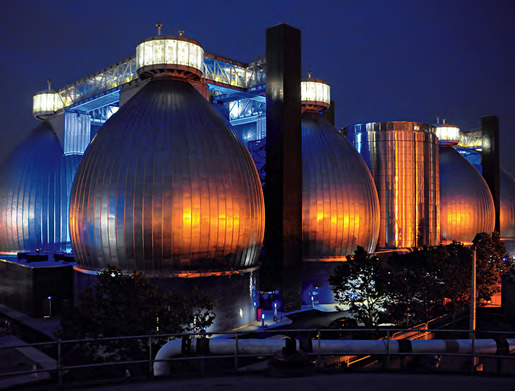The Newton Creek plant is the largest of New York City’s fourteen wastewater treatment facilities, serving approximately 1 million residents and a drainage area of more than 65 km2. It is located on Newton Creek, a 5.6 km long polluted waterway on Long Island. The plant began operation in 1967 with a capacity of 1.2 million cubic meters per day during dry weather. Upgrade work began in 1998 and will eventually raise plant capacity by 125%. The completion of Phase 1 in 2008 increased capacity by 50%. Completion of Phase 2 is expected in 2016. In addition to the fundamental need to expand capacity and eliminate odor problems, the city had other requirements.
The facility is visible from vantage points in the Brooklyn, Queens and Manhattan city boroughs, including the Long Island Expressway, the Brooklyn-Queens Expressway and the Kosciusko Bridge, making aesthetic revitalization highly desirable. Hence, the New York Department of Environmental Protection (DEP) engaged the architecture firm Polshek Partnership to work with the engineers to create an attractive facility along the estuary. Since long service life was required, material durability and resistance to the coastal salt-laden air were as important as aesthetics.
Function and form
Eight gracefully curved egg-shaped silver towers rise 44 m above the site like an alien apartment complex in a science fiction movie. These digester “eggs,” which are the project’s most visible component, will process up to 5.7 million liters of sludge every day, using anaerobic technology. At their widest point, the eggs are over 24 m in diameter.
Polshek chose to highlight these towers and make them an important sculptural element by wrapping them in 22,297 m2 of 9.5 mm thick Type 316 stainless steel. Using the strong lines of a batten seam roof system and a proprietary low reflectivity finish to softly reflect light further highlighted the elegant shape of the digesters. Type 316 stainless steel with 2% molybdenum has become the standard specification for projects in locations with coastal or deicing salt exposure for Polshek Partnership and some other prominent US architecture firms. The more commonly used Type 304 does not contain molybdenum and can have aesthetically unacceptable surface staining in environments with corrosive salt or pollution, and regular cleaning is required. This stainless steel will not be manually cleaned, making Type 316 the logical choice.
Type 316 stainless steel was also used for numerous other architectural applications including the wall panels and curved batten seam roof on six buildings, canopy cladding, louvers, railings, ladders, and doors (both interior and exterior) and handrails in the facility. In addition, stainless steel was used extensively for plant equipment that is traditionally stainless steel.


